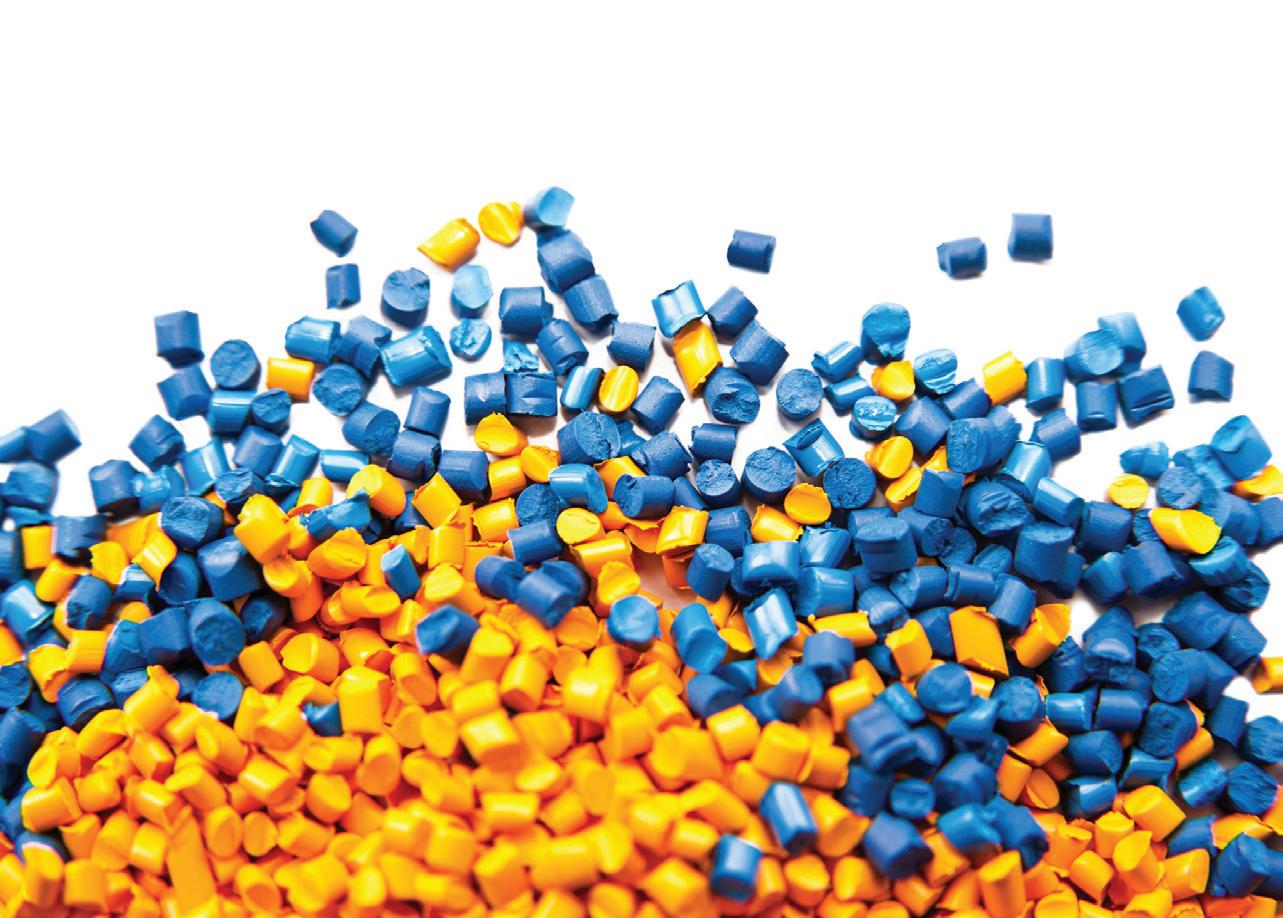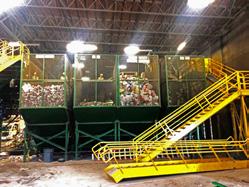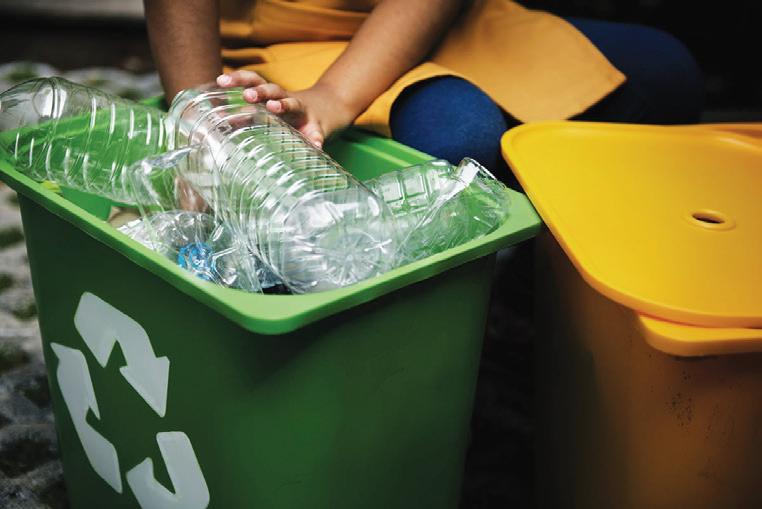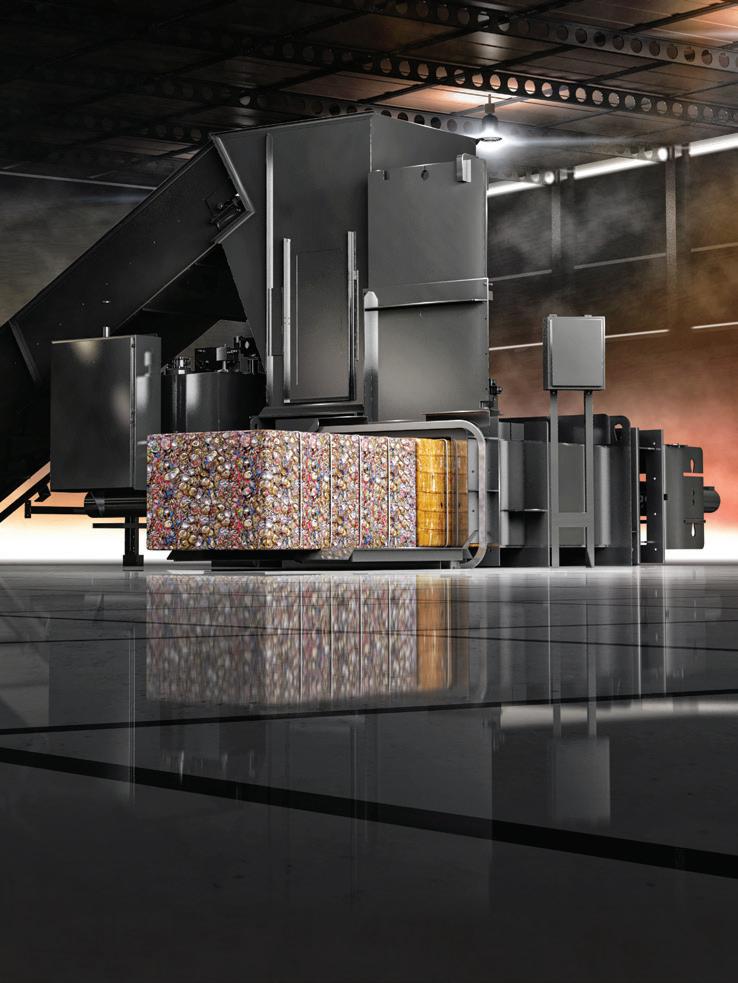
12 minute read
PLASTICS RECYCLING
THE PLASTICS INDUSTRY IS CHANGING BECAUSE IT HAS TO
MRF equipment priced to sell! 2013 cp in great working condition! 15 tons per hour For more details contact dave vaccarezza (209) 843-1811 mrfequipment@cal-waste.com IN EUROPE, THE SHIFT FROM LARGE-SCALE MECHANICAL MODELS FOR EOL PLASTIC TO SMALLER-SCALE, LOCALIZED CHEMICAL RECYCLING IS WELL UNDER WAY W hile plastic, in its myriad forms is ingrained in every aspect of our life, “plastiphobia” has entered the vernacular as a condition, and regulators around the world are cracking down hard on an industry that already faces a number of complex challenges. But plastiphobia shouldn’t be a thing at all. Plastic should not be demonized, rather it should be treated like the crux of modern living that it actually is. The problem is not with plastic per se, but with the recycling of plastic and its inappropriate usage.
The plastics industry has become acutely self-aware, and some might even say introspective. Directive targets must be met, new processes researched, developed and launched, consumer education delivered and consumer expectations met. Looming over all of this is the spectre of sustainability and the demonization of plastics.
Speaking at Circularity for Polymers: The ICIS Recycling Conference in Berlin, in 2019, Paul Hodges, Chairman of International E-Chem, said there’s an awful lot of work to do in a very limited time. “It’s very clear there's a paradigm shift going on in the industry. Companies are waking up to the fact that waste plastics are a really big issue – one that’s not going to go away. Single use plastics are going to be in the firing line for the next few years – and business models simply must change,” he said.
Hodges emphasized that at the core of the shift required is the fact that people don’t know how to recycle plastics, but they do understand why we need to: “We haven't got the technology available. We haven’t got the collection processes set up. We need to move away from throwing rubbish away at waste sites and focus instead on developing resource centres based on a distributed network of local chemical recycling plants.”
He says the move to smaller, local chemical recycling plants – which are more efficient and effective at separating out the different types of plastic to help better achieve the dream of a circular economy – is certainly on the horizon, yet still only a nascent industry.
Richard Daley is managing director of ReNew ELP, a company at the cutting edge of chemical recycling. ReNew ELP are in the final stages of development on the first of four chemical recycling processing lines, with each line processing 20,000 tonnes a year. Their Cat-HTR technology utilizes what Daley describes as “a unique hydrothermal upgrading process, using supercritical water to break down plastics into reusable, valuable chemicals and oils.” ICIS senior editor, recycling, Mark Victory commented, “Chemical recovery is better in theory – but there are issues with cost and yield. In theory, it’s good, but there are still the same challenges of collection – and it will be five to ten years – an optimisBY WILL RANKIN


tic estimate – before we see large scale chemical recovery.”
Victory identifies another hurdle, in that collection is simply not big enough. He says local authorities in Europe – where most responsibility for household waste collection lies – have been underfunded since the global economic downturn more than a decade ago, and investment in infrastructure has not kept pace with the growing complexity of packaging as a result. That domestic issue is further exacerbated by China’s decision to stop taking waste plastics from the rest of the world.
“Investment in waste collection hasn’t kept pace with the increasing complexity of packaging,” explained Victory. “And since China stopped accepting waste, there’s more contamination in our domestic recycling. Wastage rates have increased because China used to take the lower quality waste material – which they could use in industries such as textile – but is now being incorporated into domestic bales.
“The scale of demand and size of the undersupply is also meaning material is having to be produced at maximum capacity and stretched further, which also has an impact on contamination levels,” he continued. “In recycled polyethylene terephthalate, for example, we’ve seen wastage rates increase from 25 percent in 2009 to 30–35 percent currently.”
Hodges added that what the industry urgently needs is project teams to work out how to produce more sustainable product and better recycling collection and processing facilities.
“We’ve got 18 months to work this out,” he warned, “Because if we don't do it, brand owners are going to say ‘look we’ve made a commitment to the consumers to have done this by 2025. You’re not moving. So we’re going to have to do something else.’ We have six years to work this out – and we don’t know what to do.”
Hodges feels the brand owners which have committed to the 2025 deadline need reassurance from the plastics industry. “We need to reach out to brand owners and say we have got the technology sorted out, the business model sorted out and the finance sorted out, so trust us, we will now deliver so you can deliver what you need to do,” he said.
ICIS’s senior analyst of plastics recycling, Helen McGeough explained, “Plastic packaging is more complex than ever before, modern packaging has moved beyond just functionality to a marketing tool. But we need to strip it back to a simpler level and encourage recycling concepts at the design stage.
“The EU has set the bar high with the Single Use Plastic Directive, requiring higher collection rates, even with 2018 recovery rates for PET bottles in Europe at 63 percent, and 55 percent in the U.K. The European country PET collection rates range varies across member states reflecting the differences in systems, consumer participation and government ability to prioritize investment in waste management. This lack of standardisation in everything from waste infrastructure to final R-PET product specification continues to present as many challenges as opportuni-
THE NEW INDUSTRY BUSINESS MODEL IS SMALL SCALE AND LOCAL, WHEREAS FOR THE LAST 30 TO 40 YEARS, ALL WE’VE TALKED ABOUT IS MASSIVE AND GLOBAL. THIS IS A COMPLETE GAME CHANGER. “ “ PAUL HODGES
G A S • D I E S E L • E L E C T R I C D U S T & O D O R C O N T R O L E Q U I P M E N T DUST • 3 N O Z Z L E H E A D S / 3 X C O V E R A G E • 7 4 H P D I E S E L E N G I N E • N O G E N E R A T O R R E Q U I R E D T H E T R I D E N T B U F F A L O T U R B I N E B U F F A L O T U R B I N E . C O M












ties for one of the most developed recycled markets in the plastic industry.”
According to Mark Victory, the sector needs heavy investment to catch up across the entire chain. “There’s no point in everyone wanting to recycle if the infrastructure isn’t there,” he said. “We are relying on people to understand and embrace recycling systems – which is hard to predict. There’s a strong education element to it. For most people, plastic is simply plastic – they are unaware of the different types and what to do with it.”
Hodges concurred on the need for investment, emphatically suggesting the industry needs to provide funding.
“The amounts the industry is committing to this sea change is next to nothing – 25 million here, 10 million there – we’re talking about a hundred billion [dollar] industry here,” said Hodges. “You can’t start with pocket money!”
Hodges sees the biggest industry challenge – and perhaps opportunity – as the shift from massive mechanical recycling plants to smaller, local chemical recycling plants. “The new industry business model is small scale and local, whereas for the last 30 to 40 years, all we’ve talked about is massive and global,” said Hodges. “This is a complete game changer.”


In February, at GLOBE Forum 2020 in Vancouver, Jonathan Wilkinson, Canadian Minister of Environment and Climate Change (ECCC), announced three winners of the Plastics Innovation Challenge, sponsored by ECCC. Axipolymer Inc., based in Montreal, will create a recyclable multi-layer film that can be used for food packaging; GreenMantra Technologies from Brantford, will transform polystyrene insulation waste into new insulation; and MgO Systems from Calgary will use PVC waste from construction to produce new insulating materials.
These Canadian small- and mediumsized businesses will all receive $1 million each to develop prototypes of their new technologies designed to address plastic waste from food packaging and construction.
Minister Wilkinson also announced in February the launch of six new Plastics Challenges and three Clean Technology Challenges, through the Innovative Solutions Canada program. Innovative Solutions Canada has launched 14 plastics challenges to date, committing nearly $19M to support Canadian innovators and small and medium businesses in the sector.
The nine new Innovation Challenges call on Canadian companies to develop solutions to find sustainable alternatives to plastics and waste challenges in textiles, ewaste and end-of-life vehicle sectors. Other new challenges are looking to award the optimum solutions for addressing microplastics in marine environments, recycling plastic into ceiling tiles, developing waste conversion techniques, and for developing energy-producing window coverings from recycled plastic.
The Challenges will be led by Environment and Climate Change Canada, the National Research Council of Canada, Shared Services Canada and Global Affairs Canada. “The Government of Canada has committed nearly $19 million to fund Canadian innovators through the Canadian Plastics Innovation Challenge initiative, which results in real, Canadian-made solutions,” said Wilkinson.
“As Shared Services Canada continues to upgrade our antiquated IT infrastructure, we will need new ways to recycle and repurpose the associated waste from this transition,” commented Joyce Murray, Canada’s Minister of Digital Government. “The Innovative Solutions Canada challenge will promote innovation to reduce the environmental impact of end-of-life e-waste and support our greening government strategy.” According to an ECCC news release, “By improving how we manage plastic waste and investing in innovative solutions, we can reduce 1.8 million tonnes of carbon pollution, generate billions of dollars in revenue, and create approximately 42,000 jobs.” CANADIAN PLASTICS INNOVATION CHALLENGE WINNERS INCLUDE AXIPOLYMER, GREENMANTRA AND MGO
COM P A C T P O WER • TWO-RAM ON A HORIZONTAL BUDGET • VERTICAL BALE DOOR AVAILABLE • IDEAL FOR MULTI-MATERIAL FACILITIES AMERICAN BALER TAKES PERFORMANCE TO NEW HEIGHTS! I N T E G R I TY I Q U A L I TY I R E L I A B I L I TY I VA L U E B ASF, the Germany-based chemical company (and second largest chemical producer in the world) has launched a pilot project called reciChain in British Columbia designed to better manage plastic waste. BASF says the project will introduce a more sustainable alternative to linear economic models, reducing plastic waste, maximizing its value and enhancing resource efficiency. According to a report produced by Deloitte for Environment and Climate Change Canada, the country disposed of nearly 3.3 million tons of plastic waste in 2016. Of these plastics, less than 11 percent were recycled, meaning the rest were landfilled or lost to the environment. If the present trend continues, the report estimates that Canadians will dispose of $11.1 billion worth of plastic materials each year by 2030.
“There is a clear global challenge around the economics of recycling plastic,” said Marcelo Lu, president, BASF Canada. “Much of the collection and sorting activities are challenged by manual processes and material contamination. Additionally, traceability is a concern as new commitments start to emerge from brand owners and retailers.
“With reciChain, our goal is to revitalize the value of plastics and significantly improve circularity in the supply chain.”
The BASF platform combines the power of blockchain with a digital badge and loop count technology that enables the secured sharing of data among market participants, while improving the sorting, tracing and monitoring of plastics through out the value chain. The result is a more competitive circular supply chain rather than a linear one, extending the life cycle of plastics.
“A successful implementation of reciChain will result in a collaborative digital consortium that will bring together plastic manufacturers, suppliers, government entities, retailers, waste collectors and recyclers aimed at keeping the life of plastic molecules circular,” said Anthony DiPrinzio, head of BASF blockchain lab. “Leveraging blockchain technology, we can work together to ensure our products deliver back to the value chain and contribute to a circular economy.”
For the pilot project in British Columbia, BASF is working with Deloitte as a strategic advisor. The team is currently validating the pilot’s value in the local supply chain with the goal of expanding it to a nation-wide solution in order to position Canada as a leading country in the recycling and recovery of plastics.
To learn more about reciChain, visit www. basf.ca/reciChain. BASF PILOT PROJECT IN B.C. COMBINES BLOCKCHAIN, DIGITAL BADGE AND LOOP COUNT TO REVITALIZE THE VALUE OF PLASTICS










